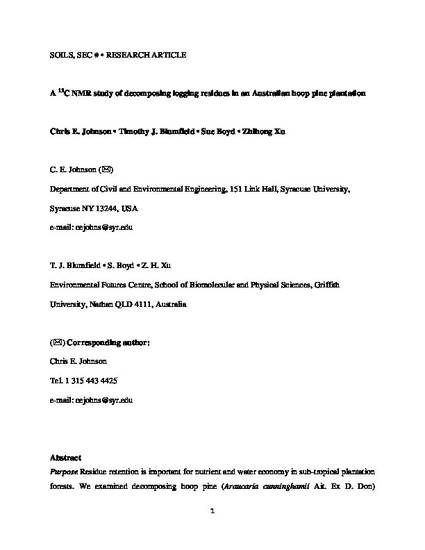
- Australia,
- Carbon,
- Decomposition,
- Forestry,
- Litter,
- Nuclear magnetic resonance spectroscopy,
- Residue management,
- Tissue chemistry
Purpose Residue retention is important for nutrient and water economy in sub-tropical plantation forests. We examined decomposing hoop pine (Araucaria cunninghamii Ait. Ex D. Don) residues – foliage, branches and stem wood – to determine the changes in structural chemistry that occur during decomposition.
Materials and methods Residues were incubated in situ using 0.05-m2 microplots. We used solid-state 13C nuclear magnetic resonance (NMR) spectroscopy to determine the structural composition of harvest residues in the first 24 months of decomposition.
Results and discussion The spectral data for branch and stem residues were generally similar to one another and showed few changes during decomposition. The lignin content of branch and foliage residues decreased during decomposition. When residues were mixed together during decomposition the O-alkyl fraction of foliage decreased initially then increased up to 24 months, while the alkyl carbon (C) fraction exhibited the opposite pattern. The decomposition of woody hoop pine residues (branch and stem wood) is surprisingly uniform across the major C forms elucidated with 13C NMR, with little evidence of preferential decomposition. When mixed with branch and stem materials, foliage residues showed significant short- and long-term compositional changes. This synergistic effect may be due to the C:N ratio of the treatments and the structure of the microbial decomposer community.
Conclusions Twenty-four months of decomposition of hoop pine residues did not result in substantial accumulation of recalcitrant C forms, suggesting that they may not contribute to long-term C sequestration.
